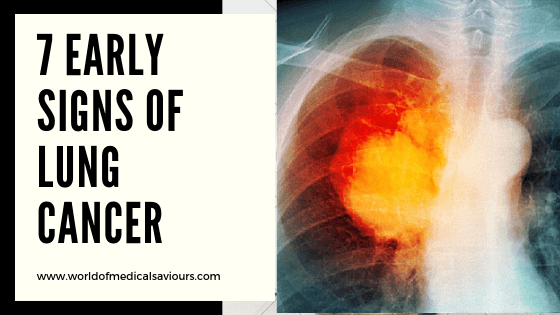Early signs of lung cancer

The most common cancer affecting population
Cancer is the rapid growth of the cells and tissue which is not necessary. Cancer can occur in any part of the body. Among the various cancer Lung cancer seems to be the most common cancer suffered by the majority of people in the population. Let’s know what are the early signs of lung cancer, adenocarcinoma lung cancer, How fast does lung cancer develop?, and What are the symptoms?
In the 20th century, the incidence of lung cancer increased rapidly due to direct result of the tobacco epidemic. In the USA and the UK,in the women, smoking prevalence and deaths from lung cancer continued to increase. More women died of lung cancer than breast cancer as well.
Once this disease advances, it usually becomes more noticeable.
Back pain, headache, weight loss, fatigue like symptoms and so on is seen. Since bone is where lung cancer to spread first so bone pain is also common. Before diagnosis most of the people who has lung cancer are unaware of the early signs of lung cancer. While some people might be have these early signs of lung cancer. These symptoms may be associated with many other conditions presents. So, these signs are rarely signs of lung cancer. The unexplained changes or difficulty in breathing if seen it should not be neglected. So the list of 7 early signs of lung cancer is described below.
Seven Early Signs of Lung Cancer
There are various signs shown by our body regarding lung cancer. If we can detect it then we can give treatment at the right time and save the person. Otherwise, it will be hard as the time passes without the detection of these signs. So, here are the seven early signs do ponder over them.
1. Cough
Early and most common symptom is cough. Cough is seen often dry in the person. Cough can have purulent sputum if secondary infection is present. If there is change in the character of a smoker’s cough than previous characters and there seems to be an association with other new symptoms. Then it should always raise suspicion of lung cancer.
2. Coughing out blood (haemoptysis)
Haemoptysis (coughing out blood) is common. It is more common in central bronchial tumours. There is a chance that it may be caused by bronchitis infection. In a smoker, haemoptysis should always be investigated to exclude the chance of lung cancer. Occasionally, central tumours invade large vessels, causing sudden massive haemoptysis that may be fatal.
3. Breathlessness
Breathlessness can be caused either by collapse or pneumonia .It can be by tumor causing a large pleural effusion. Compressing a phrenic nerve and leading to diaphragmatic paralysis may lead to breathlessness.
4. Chest pain
Aching pain is felt in the chest, back, and the tip of the shoulder if the lung cancer spreads to the chest wall or chest cavity. The pain is also felt if there is swelling of lymph nodes in that area. When you cough, laugh or breathe deeply chest pain which is caused by lung cancer tends to get worse.
But chest pain can be a sign of several serious conditions, So it is important to consult the doctor. If you feel any unexplained discomfort in chest or chest pain which persists for a long period then it needs to be investigated. Or if you are experiencing any other symptoms of heart failure such as sudden severe compressive chest pain, sweating, nausea, shortness of breath- that required immediate medical attention.
5. Hoarseness or wheezing
Lung cancer associated breathing issues are not always present as shortness of breath. They might show else symptoms like hoarseness of the voice or wheezing. If you experience any persistence change in breathing please do have a medical visit once.
6. Weight loss and loss of appetite
Lung cancer patient always experiences with the loss of appetite and unexplained weight loss. Patients receiving chemotherapy may experience with these symptoms like nausea, vomiting, taste changes, or diarrhea, which contribute to weight loss. Psychological distress is also one of the main cause of weight loss in the lung cancer patient.
7. Feeling tired or weak
Everyone experiences tiredness, but usually feelings go away after a good night’s sleep. In the lung cancer patient, the feeling does not go away even after deep sleep or rest. It may be related to the spread of cancer or it can be also the side effect of the treatment. Difficulty in promoting the everyday task can also occur.It is due to stress, sleep problem, pain, depression or anxiety, and many more. This is also one of the early signs of lung cancer.
Adenocarcinoma lung cancer:
Adenocarcinoma lung cancer is the type of cancer that develops slowly than other types of cancer. It affects the alveoli and is present on the outer edges of the lungs. It develops in glandular cells i.e gland that secret mucus. About 40 % of the patient shows this type of cancer.
Pathology
It arises from the bronchial epithelium or mucous glands. If the tumors growth occurs in large bronchus then the symptoms arise early signaling the presence of cancer. But if the tumor grows in peripheral bronchus then the symptoms are delayed which results in delayed diagnosis. The Peripheral squamous tumors may undergo central necrosis and cavitation. Due to which they might resemble as a lung abscess on X-ray. It may involve the pleura directly or by the lymphatic spread and may extend into the chest wall, invading the intercoastal nerves of the brachial plexus and causing pain. Lymphatics spread to mediastinal and supraclavicular lymph nodes often occur before diagnosis. Bloodborne metastases occur most commonly in the liver, bone, brain, adrenals, and skin. Even a small primary tumor may cause widespread metastatic deposits and this is a particular characteristic of small-cell lung cancers.
Investigations
The investigation is done to confirm the diagnosis in the suspected individual or to establish the histological cell type. It also helps in defining the progression of the disease.
Imagining
On chest X-ray ,this cancer produces a wide range of appearances when it seen in it. On X-ray it is seen from lobar collapse to mass lesions, effusion, or malignant rib destruction. CT should be performed early as possible as it may reveal mediastinal or metastatic spread and is helpful for planning biopsy procedures. E.g in establishing whether a tumor is accessible by bronchoscopy or percutaneous CT-guided biopsy.

Biopsy and histopathology
Management
Surgical resection carries the best hope of long-term survival for the patient. But for some patients when treated with radiotherapy and chemotherapy they also achieve prolonged remission or cure. Due to extensive spread or comorbidity in over 75% of cases although treatment is done with the aim of cure it is not possible or becomes inappropriate. Palliative therapy and the best supportive care are offered to such patients. Radiotherapy and chemotherapy can relieve symptoms in some cases. The management can be done by the following procedure:
- Surgical treatment
- Radiotherapy
- Chemotherapy
- Laser therapy and stenting
- General aspects of management
Prognosis
The overall prognosis in lung cancer is very poor. Although there is a diagnosis within a year 70% of patients die. Only 6-8% patient survives 5 years after diagnosis. The best prognosis is with well-differentiated squamous cell tumors that have not metastasized and are amenable to surgical resection. Adenocarcinoma lung cancer
How fast does it develop?
There is no test available to know how fast lung cancer can develop. But their growth varies from one individual to another individual. In comparatively, lung cancer develops faster than other cancer like breast cancer or prostate cancer. It would take years for cancer to be shown in Chest X-ray.
What are the symptoms of lung cancer?
The symptoms are:
- Coughing which worsens after a period of time
- Blood or phlegm is seen in cough.
- Your chest pain worsens when you breathe deeply, laugh or cough
- when you breathe there is shortness of breathe
- You feel weakness and fatigue
- Loss of hunger and weight loss
Takeaway:
Although lung cancer is fast developing cancer, if the early signs are detected, then the progression of the disease can be halted. Similarly, effective treatment will be given, which will save the life of the person. So, don’t neglect the early signs if you notice them.




